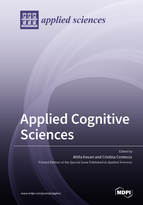Applied Cognitive Sciences
A special issue of Applied Sciences (ISSN 2076-3417). This special issue belongs to the section "Computing and Artificial Intelligence".
Deadline for manuscript submissions: closed (30 March 2022) | Viewed by 44844
Special Issue Editors
Interests: human-computer interfaces; bioinformatics; cognitive systems; IT and mechatronics applications; education
Special Issues, Collections and Topics in MDPI journals
Interests: autism spectrum disorders; neurodevelopmental disorders; cognitive and behavioral psychology; medical robotics; psychological evaluation and testing
Special Issues, Collections and Topics in MDPI journals
Special Issue Information
Dear Colleagues,
Cognitive science is an interdisciplinary field of investigation of the mind and intelligence. The term cognition refers to different mental processes, including perception, problem solving, learning, decision-making, language use, and emotional experience. The contributions of philosophy and computer science to the investigation of cognition are the basis of cognitive sciences. Computer science is very important in the investigation of cognition, because computer-aided research helps to develop the mental processes, and computers are useful in testing scientific hypotheses about mental organization and functioning. Empirical theories are very important for guiding practice (including education, pedagogy, or psychology) and operational research and engineering, in particular, the design of human-computer interfaces that can be used efficiently without placing too much emphasis on human intellectual abilities. Studies using psychological experiments and computational models are also very important in mental health diagnosis and treatment. Cognitive science plays a significant role in the field of mental illnesses, such as depression, and neurodevelopmental disorders. More specifically the understanding of the possible mechanisms that underlie them and the way interventions work require an understanding of how the mind works. This Special Issue provides a platform for a review of these disciplines and the presentation of cognitive research as an independent field of study.
Potential topics include, but are not limited to the following:
- Applications of human-computer interfaces, human factors, and human performance
- Artificial intelligence and applications in cognitive sciences
- Data analytics and computer-aided analysis in cognitive sciences
- Cognitive learning, interactive education, digital pedagogy, problem solving abilities, applications of adaptive testing
- Mental health, neurodevelopmental disorders, psychological experiments and applications
- Emotion representations and signal characteristics that describe and identify emotions or stress, user studies and evaluation techniques for emotion detection
- Measurement and collection platforms for emotion detection, presentation and applications of emotions
Prof. Dr. Attila Kovari
Prof. Dr. Cristina Costescu
Guest Editors
Manuscript Submission Information
Manuscripts should be submitted online at www.mdpi.com by registering and logging in to this website. Once you are registered, click here to go to the submission form. Manuscripts can be submitted until the deadline. All submissions that pass pre-check are peer-reviewed. Accepted papers will be published continuously in the journal (as soon as accepted) and will be listed together on the special issue website. Research articles, review articles as well as short communications are invited. For planned papers, a title and short abstract (about 100 words) can be sent to the Editorial Office for announcement on this website.
Submitted manuscripts should not have been published previously, nor be under consideration for publication elsewhere (except conference proceedings papers). All manuscripts are thoroughly refereed through a single-blind peer-review process. A guide for authors and other relevant information for submission of manuscripts is available on the Instructions for Authors page. Applied Sciences is an international peer-reviewed open access semimonthly journal published by MDPI.
Please visit the Instructions for Authors page before submitting a manuscript. The Article Processing Charge (APC) for publication in this open access journal is 2400 CHF (Swiss Francs). Submitted papers should be well formatted and use good English. Authors may use MDPI's English editing service prior to publication or during author revisions.
Keywords
- human-computer interfaces
- artificial intelligence
- data analytics
- computer-aided analysis
- adaptive testing
- cognitive learning
- interactive education
- digital pedagogy
- computer based-interventions
- problem solving
- mental health
- neurodevelopmental disorders
- psychological experiments
- human factors and human performance
- emotion representations
- emotion detection







